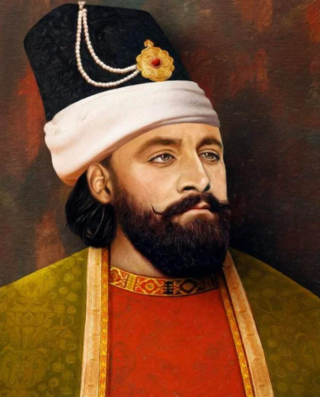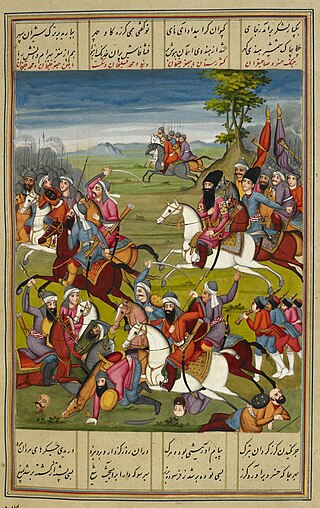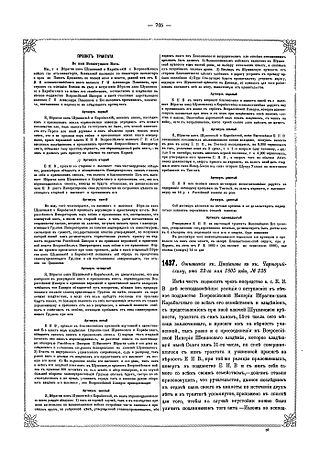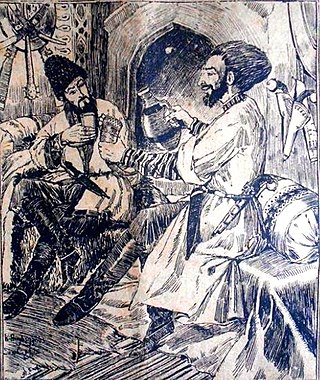Related Research Articles

The Karabakh Khanate was a khanate under Iranian and later Russian suzerainty, which controlled the historical region of Karabakh, now divided between modern-day Armenia and Azerbaijan. In terms of structure, the Karabakh Khanate was a miniature version of Iranian kingship. The administrative and literary language in Karabakh until the end of the 19th century was Persian, with Arabic being used only for religious studies, despite the fact that most of the Muslims in the region spoke a Turkic dialect.

The Ganja Khanate was a khanate under Iranian suzerainty, which controlled the town of Ganja and its surroundings, now located in present-day Azerbaijan.
Ibrahim Khalil Khan Javanshir was the second khan of the Karabakh Khanate from the Javanshir family. He was the son and successor of Panah-Ali khan Javanshir.

Panah Ali Khan Javanshir was the founder and first ruler of the Karabakh Khanate under Persian suzerainty.
Javad Khan ; c. 1748 – 1804) was a member of Ziyadoghlu Qajar, a clan of the Qajar tribe, as well as the sixth and the last khan of the Ganja Khanate from 1786 to 1804 before it was lost to Russia.
Mehdi Qoli Khan Javanshir was the last Khan of the Karabakh Khanate, functioning as its head from 1806 to 1822. His only known issue was Khurshidbanu Natavan, a famous Azerbaijani poet.
Fatali Khan or Fath Ali Khan of Quba was a khan of the Quba Khanate (1758–1789) who also managed to dominate the Derbent, Baku, Talysh and Shirvan Khanates, as well as the Salyan Sultanate during much of his reign.
Shahverdi Khan Ziyadoghlu was the beylerbey of Karabakh from 1740 to 1743 and first khan of Ganja from 1747 to 1760. He was from the Ziyadoglu branch of the Qajar clan who ruled the Beylerbeylik of Karabakh as hereditary governors.
Muhammad Hasan Khan (1742–1778) was the second Khan of Ganja from 1768 to 1780 from the Ziyadoglu branch of the Qajar clan who ruled the Beylerbeylik of Karabakh as hereditary governors.
Hajji Beg was fourth Khan of Ganja from 1784 to 1786. A member of Ziyadoghlu Qajar family Hajji Beg led a rebellion against the Georgian troops occupying Ganja in 1783 with support from Ibrahim Khalil of Karabakh and ruled the khanate from late 1783 to 1786. After successful rebellion, he invited Ali bek, the leader of Dzhengutay Kumyks to protect Ganja, whom were under attack from Heraclius II who did not want to come to terms with the loss of Ganja. Already in the autumn of 1784, with the help of Russian troops led by colonel Stepan Burnashev (1743-1824), he undertook a campaign against Ganja.

Jafar Qoli Khan Donboli was the last khan of the Khoy Khanate from 1798 to 1799 and penultimate Khan of Shaki from 1806 to 1814.
Abu'l-Fath Khan Javanshir was an Iranian commander who participated in the Russo-Iranian War of 1804–1813. He was the son of Ibrahim Khalil Khan, a member of the Javanshir tribe and governor of the Karabakh Khanate in the South Caucasus.

Kurakchay treaty is a contract confirming the integration of the Karabakh Khanate into the Russian Empire. The signing ceremony took place on May 14, 1805, in a Russian military camp on the banks of the Kurekchay river, not far from Ganja. The agreement was signed by Ibrahim Khalil Khan and Commander-in-Chief of Georgia, Infantry General Pavel Tsitsianov.

Dmitry Tikhonovich Lisanevich was a prominent general of Imperial Russian Army. He is best known for negotiation of The Treaty of Kurakchay and killing of Ibrahim Khalil Khan of Karabakh.

Umma Khan V Avar nicknamed Great or Mad — Avar nutsal, ruler of Avar Khanate from 1774 to 1801. Under Khan, the Avar Khanate expanded its borders both by subordinating the Avar free societies, and at the expense of neighboring territories. Khan was paid tributes by the Georgian king Erekle II, Derbent, Quba, Baku, Shirvan, Shaki khans and Akhaltsikhe pasha.
Muhammad Khan, Mammad Khan or Muhammad II of Ganja (1738–1780) was the third Khan of Ganja from 1768 to 1780 from the Ziyadoglu branch of the Qajar clan who ruled the Beylerbeylik of Karabakh as hereditary governors.
Ziyadoghlu Qajar or Ziyadlu were a branch of the Qajar tribe that governed Safavid Karabakh from 1546–1554 to 1743, Astarabad in various times, Ganja Khanate from 1747 to 1805. Some authors suggested that, Qovanlu branch of Qajars who ruled Iran from 1789 to 1925, which is currently better known as Qajar dynasty was a cadet-branch of Ziyadoghlu family.
Ughurlu Khan or Oghurlu Khan was a claimant to Khanate of Ganja and a member Ziyadoghlu Qajar, a clan of the Qajar tribe.
Abbas Qoli Khan Kangarli was one of the rulers of the Nakhichevan Khanate in Afsharid Iran.
Vali Qoli Khan Kangarli was the 5th khan of the Nakhichevan Khanate who was succeeded by Abbas Qoli Khan Kangarli and held office from 1773 to 1780/1781.
References
- ↑ Babayev 2003, p. 22.
- ↑ Bournoutian, George A. (2021). From the Kur to the Aras : a military history of Russia's move into the South Caucasus and the first Russo-Iranian war, 1801-1813. Leiden. p. 252. ISBN 90-04-44516-1. OCLC 1233024208.
{{cite book}}: CS1 maint: location missing publisher (link) - ↑ Babayev 2003, p. 31.
- ↑ Akopyan, Alexander V (Autumn 2008). "Ganja Coins of Georgian Types, AH 1200–1205" (PDF). Journal of the Oriental Numismatic Society. 197 (Supplement: Caucasian Numismatics, Papers on the Coinage of Kartl-Kakheti (Eastern Georgia), 1744–1801): 47–52. Archived from the original (PDF) on 2013-12-11.
{{cite journal}}: CS1 maint: year (link) - ↑ Babayev 2003, p. 32.
- ↑ Berge, Adolf (1875). Акты, собранные Кавказской археографической комиссией [Acts collected by the Caucasian Archaeographic Commission]. Tbilisi. p. 905.
{{cite book}}: CS1 maint: location missing publisher (link)